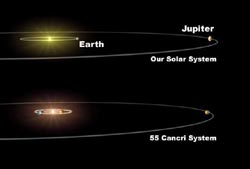Newfound Planetary System Has "Hometown" Look

This graphic depiction compares our solar system with a newfound planetary system, 55 Cancri. The new system has a planet in an orbit similar to the orbit of our Jupiter. In addition, two other planets (one confirmed) are shown orbiting 55 Cancri at distances closer than the distance between Earth and our Sun. <br>A high resolution (65K) version of this image is available at http://www.jpl.nasa.gov/images/newplanets/ 55cancri_caption.html <br> <br>Image courtesy: JPL <br>
After 15 years of observation and a lot of patience, the world’s premier planet-hunting team has found a planetary system that reminds them of our home solar system.
Geoffrey Marcy, astronomy professor at the University of California, Berkeley, and astronomer Paul Butler of the Carnegie Institution of Washington, D.C., today announced the discovery of a Jupiter-like planet orbiting a Sun-like star at nearly the same distance as the Jovian system orbits our sun.
“All other extrasolar planets discovered up to now orbit closer to the parent star, and most of them have had elongated, eccentric orbits. This new planet orbits as far from its star as our own Jupiter orbits the sun,’’ said Marcy. The National Science Foundation (NSF) and NASA fund the planet-hunting team.
The star, 55 Cancri in the constellation Cancer, was already known to have one planet, announced by Butler and Marcy in 1996. That planet is a gas giant slightly smaller than the mass of Jupiter and whips around the star in 14.6 days at a distance only one-tenth that from Earth to the sun.
Using as a yardstick the 93-million mile Earth-sun distance, called an astronomical unit or AU, the newfound planet orbits at 5.5 AU, comparable to Jupiter’s distance from our sun of 5.2 AU (about 512 million miles). Its slightly elongated orbit takes it around the star in about 13 years, comparable to Jupiter’s orbital period of 11.86 years. It is 3.5 to 5 times the mass of Jupiter.
“We haven’t yet found an exact solar system analog, which would have a circular orbit and a mass closer to that of Jupiter. But this shows we are getting close, we are at the point of finding planets at distances greater than 4 AU from the host star,” said Butler.
“I think we will be finding more of them among the 1,200 stars we are now monitoring,” he added.
The team shared its data with Greg Laughlin, assistant professor of astronomy and astrophysics at the University of California, Santa Cruz. His dynamical calculations show that an Earth-sized planet could survive in a stable orbit between the two gas giants. For the foreseeable future, existence of any such planet around 55 Cancri will remain speculative.
Marcy, Butler and their team also announced a total of 15 new planets today, including the smallest ever detected: a planet circling the star HD49674 in the constellation Auriga at a distance of .05 AU, one-twentieth the distance from Earth to the sun. Its mass is about 15 percent that of Jupiter and 40 times that of Earth. This brings the total number of known planets outside our solar system to 91.
Discovery of a second planet orbiting 55 Cancri culminates 15 years of observations with the 3-meter (118-inch) telescope at Lick Observatory, owned and operated by the University of California. The team also includes Debra Fischer, UC Berkeley; Steve Vogt, UC Santa Cruz; Greg Henry, Tennessee State University, Nashville; and Dimitri Pourbaix, the Institut d’Astronomie et d’Astrophysique, Université Libre de Bruxelles.
Marcy and Butler used a technique that measures the slight Doppler shift in starlight caused by a wobble in the star’s position, due to the gravitational tug of an orbiting planet. By observing over a period of years, they can infer a planet’s approximate mass and orbital size and period.
The star 55 Cancri is 41 light years from Earth and is about 5 billion years old. Further data are needed to determine whether yet another planet is orbiting it, because the two known planets do not explain all the observed Doppler wobbling. One possible explanation is a Saturn-mass planet orbiting about .24 AU from the star.
Media Contact
More Information:
http://exoplanets.orgAll latest news from the category: Physics and Astronomy
This area deals with the fundamental laws and building blocks of nature and how they interact, the properties and the behavior of matter, and research into space and time and their structures.
innovations-report provides in-depth reports and articles on subjects such as astrophysics, laser technologies, nuclear, quantum, particle and solid-state physics, nanotechnologies, planetary research and findings (Mars, Venus) and developments related to the Hubble Telescope.
Newest articles

First-of-its-kind study uses remote sensing to monitor plastic debris in rivers and lakes
Remote sensing creates a cost-effective solution to monitoring plastic pollution. A first-of-its-kind study from researchers at the University of Minnesota Twin Cities shows how remote sensing can help monitor and…

Laser-based artificial neuron mimics nerve cell functions at lightning speed
With a processing speed a billion times faster than nature, chip-based laser neuron could help advance AI tasks such as pattern recognition and sequence prediction. Researchers have developed a laser-based…

Optimising the processing of plastic waste
Just one look in the yellow bin reveals a colourful jumble of different types of plastic. However, the purer and more uniform plastic waste is, the easier it is to…


